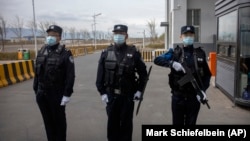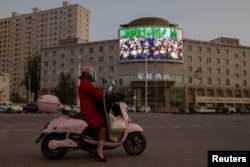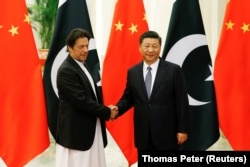China has used its massive economic clout in Pakistan to gain Islamabad’s cooperation in its transnational campaign targeting Uyghurs, a model that Beijing wants to export across Asia and the Middle East, a new report finds.
Pakistan was the first country to actively collaborate with Beijing in monitoring and extraditing Uyghurs to China, deporting 14 Uyghurs accused of being terrorists in 1997. They were all summarily executed.
Since then, China has deepened its historically strong ties with Islamabad with an estimated $60 billion worth of energy and infrastructure projects under the guise of the China-Pakistan Economic Corridor (CPEC), which is part of Beijing’s worldwide Belt and Road Initiative (BRI).
The report, compiled by the Oxus Society for Central Asian Affairs and the Uyghur Human Rights Project, asserts that this is part of a deliberate Chinese strategy centered upon “offering extravagant development projects while deepening security ties,” which has been effective in influencing the Pakistani government to help target the country’s Uyghur community.
Beijing relies on the cooperation of neighboring governments in order to target and track Uyghurs abroad, the report notes, and China is now trying to use its relationship with Pakistan as a template for other countries that have Uyghur populations.
“We can see that Pakistan is a precursor to the trends that are unfolding in the Middle East and Central Asia,” Bradley Jardine, the director of research at the Oxus Society for Central Asian Affairs and one of the report’s authors, told RFE/RL. “The agreements and arrangements reached between Beijing and Islamabad present a model that China is now trying to export across the region.”
Beijing’s crackdown on its northwestern Xinjiang Province -- where more than 1 million Uyghurs, Kazakhs, Kyrgyz, and other Muslim minorities have been detained in a vast internment camp network, according to UN estimates -- has coincided with an accelerated push to monitor and target Uyghurs living outside of China.
“Uyghurs who live in China’s neighboring countries are having their communications monitored, their movement limited, their businesses shut down, and they are being detained and extradited to China,” Robert Evans, an expert at the American Enterprise Institute and one of the report’s authors, told RFE/RL.
An Eye On Pakistan
Beijing has denied all accusations about abuses in Xinjiang and said that its system of so-called “reeducation camps” is necessary to provide vocational training and to fight against religious extremism.
An estimated 1 million to 1.6 million Uyghurs live abroad, according to the World Uyghur Congress, with the largest populations in Central Asia and Turkey.
China’s campaign against Uyghurs abroad has received support from large swathes of Pakistan’s elite, including Prime Minister Imran Khan, who has defended Beijing’s stance on Xinjiang on numerous occasions.
During a recent interview with Chinese state media, Khan went on to defend China’s official position over the camps in Xinjiang, where in addition to interning Uyghurs and other groups, Beijing has built a vast internal surveillance system to monitor the province’s residents.
“Because we have a very strong relationship with China and because we have a relationship based on trust, we actually accept the Chinese version,” Khan said during a July 1 interview with Chinese media. “What they say about the programs in Xinjiang, we accept it.”
The report also focuses on the situation in Afghanistan, which is home to a small Uyghur diaspora, and where the Taliban is making steady territorial gains and has also recently held talks with Chinese officials.
Islamabad is the group’s main political patron and China has recently accelerated its diplomatic outreach in order to gain the Taliban’s cooperation in targeting Uyghur militants in the country, a move that could have far-reaching implications.
“There is growing anxiety among Uyghurs in Afghanistan now, especially as China and Pakistan plan to expand the CPEC into the country,” said Evans.
In addition to its giant economic footprint, Beijing’s increased heft across Central and South Asia has expanded through the use of multilateral organizations like the Shanghai Cooperation Organization (SCO) -- a Eurasian security bloc that contains India, Kazakhstan, Kyrgyzstan, Pakistan, Tajikistan, and Uzbekistan.
The SCO’s focus is to combat what the organization calls the “three evils” of terrorism, extremism, and separatism, which are vaguely defined by the members states and, as the report notes, has allowed SCO countries “to take advantage of these loose definitions to pursue political opponents abroad.”
This cooperation with China has also expanded to Tajikistan, where Beijing operates a series of military outposts along the Afghan border used to monitor and potentially detain Uyghur militants in the area.
An Expanding Template
The report highlights the growing risk posed by digital surveillance against the country’s Uyghur community in Pakistan, where China has deployed its spyware programs with the consent of local security services.
In June 2020, the digital security company Lookout published a report documenting how Chinese sources had been installing spyware on Pakistani phones.
According to the study, the spyware had mainly found its way onto phones owned by ethnic Uyghurs in the country through third-party apps found on websites and ads. Once installed on the device, personal information from the phone, including location data, text and audio conversations, and contact information were all collected and stored.
“What we are seeing is the spread of Xinjiang’s own internal model being exported and adopted across the surrounding region, increasingly in Pakistan,” said Jardine.
The CPEC has also provided the foundation for the expansion of Chinese surveillance programs in Pakistan, according to a leaked document obtained by the Pakistani newspaper Dawn in 2017.
The document outlined new types of electronic surveillance and new border systems that Jardine says could be used to single out Uyghurs and be more widely implemented across the region.
“As a whole, Central Asia has the largest Uyghur diaspora in the world,” said Jardine. “The spread of this technology puts the community at risk, whether it’s by direct monitoring or by restricting freedom of movement.”
Beijing's “safe cities” program, which includes video surveillance, facial-recognition cameras, and the storage of vast amounts of data, is already expanding across Central Asia.
Kazakhstan has been conducting a test version of the program in partnership with Hikvision, a Chinese tech company that is currently under U.S. sanctions and has developed racial-profiling technology to identify the faces of Uyghurs in crowds.
Similarly, the China National Electronics Import and Export Corporation, another Chinese company under U.S. sanctions, has provided free facial-recognition software to Kyrgyzstan’s police force through a Chinese program to expand the smart cities framework in Bishkek.
“The smart cities are part of this Chinese template,” said Jardine. “It’s part of a larger top-down security structure that is increasingly targeting Uyghurs, but could be expanded to target other groups as well.”














